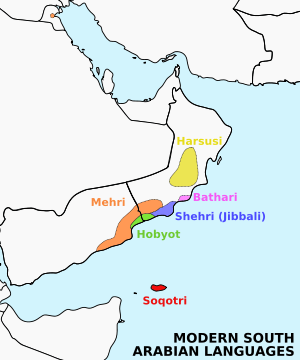Modern South Arabian languages
| Modern South Arabian | |
|---|---|
| Geographic distribution: | Yemen, Oman |
| Linguistic classification: |
|
| Subdivisions: | |
| Glottolog: | mode1252[1] |
 | |
The Modern South Arabian (Eastern South Semitic or Eastern South Arabian) languages are spoken mainly by small populations inhabiting the Arabian Peninsula, in Yemen and Oman. Together with the modern Ethiopian Semitic languages, they form the South Semitic sub-branch of the Afro-Asiatic family's Semitic branch.
Classification
In his glottochronology-based classification, Alexander Militarev presents the Modern South Arabian languages as a South Semitic branch opposed to a North Semitic branch that includes all the other Semitic languages.[2][3] They are no longer considered to be descendants of the Old South Arabian language, as was once thought, but instead "nephews".
Grammar
Modern South Arabian languages are known for their apparent archaic Semitic features, especially in their system of phonology. For example, they preserve the lateral fricatives of Proto-Semitic.
Additionally, Militarev identified a Cushitic substratum in Modern South Arabian, which he proposes is evidence that Cushitic speakers originally inhabited the Arabian Peninsula alongside Semitic speakers (Militarev 1984, 18-19; cf. also Belova 2003). According to Václav Blažek, this suggests that Semitic peoples assimilated their original Cushitic neighbours to the south who did not later emigrate to the Horn of Africa. He argues that the Levant would thus have been the Proto-Afro-Asiatic Urheimat, from where the various branches of the Afro-Asiatic family subsequently dispersed. To further support this, Blažek cites analysis of rock art in Central Arabia by Anati (1968, 180-84), which notes a connection between the shield-carrying "oval-headed" people depicted on the cave paintings and the Arabian Cushites from the Old Testament, who were similarly described as carrying specific shields.[4]
Languages
- Mehri: the largest Modern South Arabian languages, with more than 70,000 speakers in Yemen. In addition to these, more than 50,000 live in Oman, and about 15,000 are situated farther afield in Kuwait due to emigration. The population total for all countries is 135,764 (SIL 2000). Mehri people are referred to as Mahra.
- Soqotri: another relatively numerous example, with speakers on the island of Socotra isolated from the pressures of Arabic on the Yemeni mainland. According to the 1990 census in Yemen, the number of speakers there was 57,000 (including, perhaps, Soqotris living on the mainland). The population total for all countries (including work emigrants) is estimated at 64,000.
- Shehri: frequently called Jibbali "of the Mountains", with an estimated 25,000 speakers; it is best known as the language of the rebels during the rebellion in Oman's Dhofar Governorate along the border with Yemen in the 1960s and 1970s.
- Bathari: 200 speakers est.
- Harsusi: 1000–2000 speakers est., in Oman.
- Hobyót: 100 speakers est., in Oman.
References
- ↑ Hammarström, Harald; Forkel, Robert; Haspelmath, Martin; Bank, Sebastian, eds. (2016). "Modern South Arabian". Glottolog 2.7. Jena: Max Planck Institute for the Science of Human History.
- ↑ http://www.krugosvet.ru/articles/77/1007711/1007711a1.htm
- ↑ Militarev, Alexander, "Once more about glottochronology and the comparative method: the Omotic-Afrasian case". Moscow, Russian State University for the Humanities. http://starling.rinet.ru/Texts/fleming.pdf
- ↑ Blažek, Václav. "Afroasiatic Migrations: Linguistic Evidence" (PDF). Retrieved 9 May 2013.
Bibliography
- Johnstone, T.M. 1975. The Modern South Arabian Languages. Afroasiatic Linguistics 1/5:93-121 [1-29
- Johnstone, T.M. 1977. Ḥarsūsi Lexicon and English-Ḥarsūsi Word-List. London: Oxford University Press.
- Johnstone, T.M. 1981. Jibbāli Lexicon. London: Oxford University Press.
- Johnstone, T.M. 1987. Mehri Lexicon and English-Mehri Word-List. London: School of Oriental and African Studies.
- Nakano, Aki’o. 1986. Comparative Vocabulary of Southern Arabic: Mahri, Gibbali, and Soqotri. Tokyo: Institute for the Study of *Languages and Cultures of Asia and Africa.
- Nakano, Aki’o. 2013. Hōbyot (Oman) Vocabulary: With Example Texts. Ed. Robert Ratcliffe. Tokyo: Research Institute for Languages and Cultures of Asia and Africa.
- Naumkin, Vitaly, et al. 2014b. Corpus of Soqotri Oral Literature. Volume 1. Leiden: Brill.
- Rubin, Aaron D. 2010. The Mehri Language of Oman. Leiden: Brill.
- Rubin, Aaron D. 2014. The Jibbali Language of Oman: Grammar and Texts. Leiden: Brill.
- Watson, Janet C.E. 2012. The Structure of Mehri. Wiesbaden: Harrassowitz.
External links
- The Modern South Arabian Languages, by M.C.Simeone-Senelle